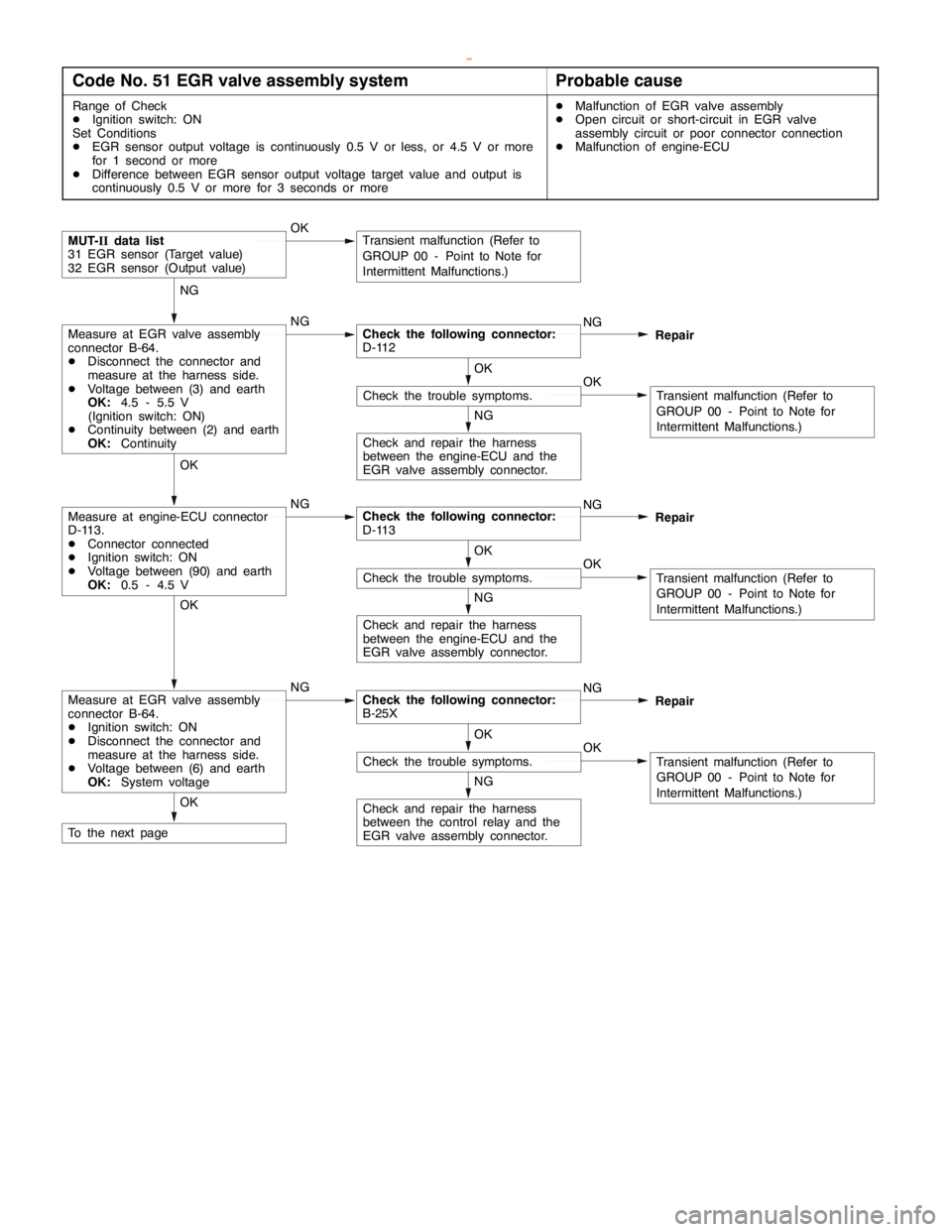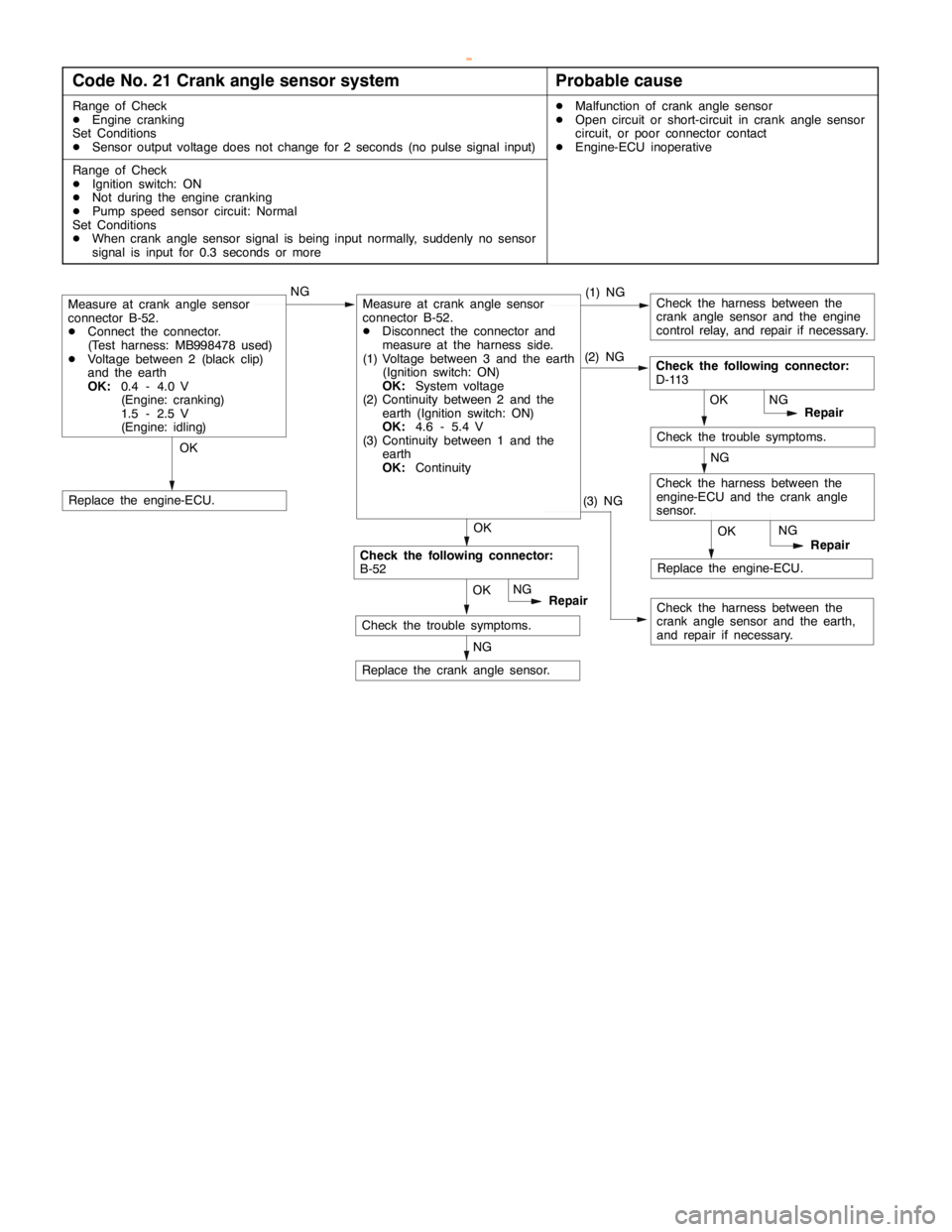2000 MITSUBISHI MONTERO relay
[x] Cancel search: relayPage 562 of 1839

DIESEL FUEL <4M4> -Troubleshooting13C-7
Code No. 48 GE actuator (in the middle of control sleeve
position sensor inoperative) systemProbable cause
Range of Check
DIgnition switch: ON
Set Conditions
DTarget value minus actual value for 0.5 second is 1 V or more.DControl sleeve position sensor inoperative
DGE actuator inoperative
DControl sleeve position sensor open circuit, short
circuit, or connector contact inoperative
DEngine-ECU inoperative
NGGE actuator check (Refer to
P.13C-46.*)Replace injection pump assembly.
NGMeasure at B-38 injection pump
assembly connector.
DDisconnect the connector and
measure at the harness side.
DVoltage between 6 and the earth
(Ignition switch: ON)
OK:System voltageCheck and repair the harness
between the control relay and the
injection pump assembly connector. OK
Check the following connector:
D-110NG OK
Repair
Check the trouble symptoms.Replace the engine-ECU. OK
NOTE:
*: Refer to the 2001 PAJERO Workshop Manual (Pub. No. PWJE0001).
www.WorkshopManuals.co.uk
Purchased from www.WorkshopManuals.co.uk
Page 563 of 1839

DIESEL FUEL <4M4> -Troubleshooting13C-8
Code No. 51 EGR valve assembly systemProbable cause
Range of Check
DIgnition switch: ON
Set Conditions
DEGR sensor output voltage is continuously 0.5 V or less, or 4.5 V or more
for 1 second or more
DDifference between EGR sensor output voltage target value and output is
continuously 0.5 V or more for 3 seconds or moreDMalfunction of EGR valve assembly
DOpen circuit or short-circuit in EGR valve
assembly circuit or poor connector connection
DMalfunction of engine-ECU
Check and repair the harness
between the engine-ECU and the
EGR valve assembly connector.
NG
OKCheck the trouble symptoms.
OK
Transient malfunction (Refer to
GROUP 00 - Point to Note for
Intermittent Malfunctions.)
NGMeasure at engine-ECU connector
D-113.
DConnector connected
DIgnition switch: ON
DVoltage between (90) and earth
OK:0.5 - 4.5 VCheck the following connector:
D-113NG
Repair OK
Check and repair the harness
between the engine-ECU and the
EGR valve assembly connector.
NG
OKCheck the trouble symptoms.
OK
Transient malfunction (Refer to
GROUP 00 - Point to Note for
Intermittent Malfunctions.)
OKMUT-IIdata list
31 EGR sensor (Target value)
32 EGR sensor (Output value)Transient malfunction (Refer to
GROUP 00 - Point to Note for
Intermittent Malfunctions.)
NGMeasure at EGR valve assembly
connector B-64.
DDisconnect the connector and
measure at the harness side.
DVoltage between (3) and earth
OK:4.5 - 5.5 V
(Ignition switch: ON)
DContinuity between (2) and earth
OK:ContinuityCheck the following connector:
D-112NG
Repair NG
To the next pageOK
Check and repair the harness
between the control relay and the
EGR valve assembly connector.
NG
OKCheck the trouble symptoms.
OK
Transient malfunction (Refer to
GROUP 00 - Point to Note for
Intermittent Malfunctions.)
NGMeasure at EGR valve assembly
connector B-64.
DIgnition switch: ON
DDisconnect the connector and
measure at the harness side.
DVoltage between (6) and earth
OK:System voltageCheck the following connector:
B-25XNG
Repair OK
www.WorkshopManuals.co.uk
Purchased from www.WorkshopManuals.co.uk
Page 566 of 1839

DIESEL FUEL <4M4> -Troubleshooting13C-11
ENGINE-ECU CHECK
TERMINAL VOLTAGE TABLE
Terminal No.Check itemInspection conditions (engine status)Normal condition
14Throttle body assembly (1)Ignition switch: ON (Engine stops)9 V or more
17EGR motorIgnition switch: ON (Engine stops)System voltage
18Throttle body assembly (2)Ignition switch: ON (Engine stops)9 V or more
19Throttle body assembly (3)Ignition switch: ON (Engine stops)9 V or more
20Throttle body assembly (4)Ignition switch: ON (Engine stops)9 V or more
33A/C load signalEngine: Idle
A/C switch: ONDuring weak cooling or
heatingSystem voltage
During normal cooling0-1V
During strong coolingChanges repeatedly
between 0 V and 12 V
37Clutch switch
Inhibitor switch Ignition switch:
ON (Engine stops)Move selector lever to N
or P0-1V
Move selector lever to D,
2, L or RSystem voltage
38Control relay (no immobi-
lizer)
Ignition switch: ON0-1V
lizer)
Ignition switch: ON→OFF (after approx. 8
seconds)System voltage
41Select switch
ON (Engine stops)Move shift lever to 4st or
RSystem voltage
421st - 2nd switch
ON (Engine stops)Move shift lever to 1st or
2ndSystem voltage
433rd - 4th switch
ON (Engine stops)Move shift lever to 3rd or
4thSystem voltage
445th - R switch
ON(Enginestops)
Move shift lever to 5th0-1V
ON(Engine stops)
Move shift lever to RSystem voltage
58TachometerDuring idlingChanges repeatedly
between 0 V and 12 V
90EGR valve sensorDuring racingChanges between 0.5
V and 4.5 V
www.WorkshopManuals.co.uk
Purchased from www.WorkshopManuals.co.uk
Page 596 of 1839

MITSUBISHI SC-Troubleshooting MITSUBISHI SC-Troubleshooting13E-7
OK
NG
Repair
OK
Check the trouble symptoms.
NG
OKNG
Repair
OK
(1)NGCheck the following connectors:
B-25X, D-128, E-122,
E-121
NG
Check the harness wire between the engine control relay and
the SC-ECU, and repair if necessary. (2)NG
OK
Check the trouble symptoms.
NG
Replace
NG
Check the harness wire between the battery and the SC-ECU,
and repair if necessary.
Check the following connectors:
D-27, D-223
D-31
Measure at SC-ECU connectors E-120, E-121.
DDisconnect the connector and measure at the harness
side.
(1) Voltage between terminal 25 and body earth
(Ignition switch: ON)
OK:
System voltage
(2) Voltage between terminal 39 and body earth
OK:
System voltage
NG (1)NG
Check the harness wire between the SC-ECU and the body
earth, and repair if necessary.
Repair
NG
Replace the SC-ECU.
Check the trouble symptoms.
Check the following connectors:
E-120, E-122
NG
(2), (3)NG
Check the harness wire between the SC-ECU and the body
earth, and repair if necessary.
OK
NG
Repair
NGCheck the trouble symptoms.
Check the following connector:
E-121, E-122
OK
Check the trouble symptoms.
Measure at SC-ECU connector E-120, E-121.
DDisconnect the connector and measure at the harness
side.
(1) Continuity between 31 and body earth
OK:
Continuity
(2) Continuity between 13 and body earth
OK:
Continuity
(3) Continuity between 26 and body earth
OK:
Continuity
Check the trouble symptoms.
Check the fusible link No.2 and dedicated fuse No.7
Code No. 51 Vehicle speed sensor systemProbable cause
This diagnosis code will be set when the vehicle speed signal from the vehicle
speed sensor is not the same as that from the wheel speed sensor (FR).DMalfunction of vehicle speed sensor system
DMalfunction of wheel speed sensor system
DMalfunction of the SC-ECU
NG
Check the trouble symptoms.
Replace the SC-ECU.YES
NOCheck the vehicle speed sensor system (Refer to Basic
Manual GROUP 54A - Combination Meter).Does the speedometer operate normally?
YES
NOCheck the ABS system (Refer to Basic Manual GROUP 35B
- ABS).Does the ABS system operate normally?
www.WorkshopManuals.co.uk
Purchased from www.WorkshopManuals.co.uk
Page 602 of 1839

MITSUBISHI SC-Troubleshooting13E-13
Inspection procedure 2
Communication with MUT-
IIand the SC-ECU is not
possible.
Probable cause
The cause is probably an open circuit in the SC-ECU power supply circuit or an
open circuit in the diagnosis output circuit.DMalfunction of harness or connector
DMalfunction of the SC-ECU
NG
Repair
OK
Check the trouble symptoms.
NG
Check the harness wire between SC-ECU and diagnosis
connector, and repair if necessary.
OK
Measure at SC-ECU connector E-121 and diagnosis connector
D-23.
DDisconnect the connectors and measure at the harness
side.
DContinuity between the following terminals:
Between terminals 1 (SC-ECU side) and 1 (diagnosis
connector side)
Between terminals 14 (SC-ECU side) and 7 (diagnosis
connector side)
Between terminals 23 (SC-ECU side) and 14 (diagnosis
connector side)
OK:
ContinuityNGCheck the following connectors:
E-121, E-122, D-128, E-13,
D-33, D-222, D-23
OK
NG
Repair
OK
Check the trouble symptoms.
NG
OKNG
Repair
OK
(1)NGCheck the following connectors:
B-25X, D-128, E-122,
E-121
NG
Check the harness wire between the engine control relay and
the SC-ECU, and repair if necessary. (2)NG
OK
Check the trouble symptoms.
NG
Replace
NG
Check the harness wire between the battery and the SC-ECU,
and repair if necessary.
Check the following connectors:
D-27, D-223
D-31
Measure at SC-ECU connectors E-120, E-121.
DDisconnect the connector and measure at the harness
side.
(1) Voltage between terminal 25 and body earth
(Ignition switch: ON)
OK:
System voltage
(2) Voltage between terminal 39 and body earth
OK:
System voltage
NG (1)NG
Check the harness wire between the SC-ECU and the body
earth, and repair if necessary.
Repair
NG
Replace the SC-ECU.
Check the trouble symptoms.
Check the following connectors:
E-120, E-122
NG
(2), (3)NG
Check the harness wire between the SC-ECU and the body
earth, and repair if necessary.
OK
NG
Repair
NGCheck the trouble symptoms.
Check the following connector:
E-121, E-122
OK
Check the trouble symptoms.
Measure at SC-ECU connector E-120, E-121.
DDisconnect the connector and measure at the harness
side.
(1) Continuity between 31 and body earth
OK:
Continuity
(2) Continuity between 13 and body earth
OK:
Continuity
(3) Continuity between 26 and body earth
OK:
Continuity
Check the trouble symptoms.
Check the fusible link No.2 and dedicated fuse No.7
www.WorkshopManuals.co.uk
Purchased from www.WorkshopManuals.co.uk
Page 611 of 1839

13E-1
DIESEL FUEL
<4D5-STEPIII
>
CONTENTS
GENERAL 2.................................
Outline of Change 2............................
GENERAL INFORMATION 2...................
SERVICE SPECIFICATIONS 4.................
SEALANT 4..................................
SPECIAL TOOLS 5...........................
TROUBLESHOOTING 6.......................
ON-VEHICLE SERVICE 55....................
Injection Nozzle Check and Adjustment 55.........
Injection Timing Check and Adjustment 55.........
Idle Speed Check and Adjustment 55.............
Accelerator Pedal Position Sensor (APS)
Adjustment 56.................................
Control Relay Continuity Check 57................
Accelerator Pedal Position Sensor (APS)
Check 57......................................Idle Switch Check 58............................
Boost Air Temperature Sensor (Intake Air
Temperature Sensor) Check 58..................
Engine Coolant Temperature Sensor Check 59.....
Evacuation of Water from Fuel Filter 59............
Fuel Filter Cartridge Replacement 60..............
Evacuation of Air from Fuel Line 60...............
EGR Valve Position Sensor Check 60.............
Fuel Injection Pump Check 61....................
Throttle Solenoid Valve Check 62.................
Throttle Actuator Check 63......................
Variable Geometry Solenoid Valve Check 63.......
EGR Control Solenoid Valve Check 63............
FUEL INJECTION NOZZLE 64.................
FUEL INJECTION PUMP 64...................
CRANKSHAFT POSITION SENSOR 66.........
ENGINE-ECU 66.............................
www.WorkshopManuals.co.uk
Purchased from www.WorkshopManuals.co.uk
Page 612 of 1839

DIESEL FUEL <4D5-stepIII>-General/General Information13E-2
GENERAL
OUTLINE OF CHANGE
An electronically-controlled injection pump has been added in order to comply with Regulation STEP
III. Due to this, the following service procedures have been added.
GENERAL INFORMATION
The electronically-controlled fuel injection system consists of sensors which detect the condition of the
diesel engine, an engine-ECU which controls the system based on signals from these sensors, and actuators
which operate according to control commands from the engine-ECU.
The engine-ECU carries out operations such as fuel injection rate control, fuel injection timing control
and idle up control. In addition, the engine-ECU is equipped with several self-diagnosis functions which
make troubleshooting easier in the event that a problem develops.
FUEL INJECTION RATE CONTROL
The fuel injection completion timing is controlled by means of a solenoid-type spill valve to ensure that
the optimum amount of fuel is supplied to the engine in accordance with gradual changes in the engine
running condition.
Before fuel injection starts, the solenoid-type spill valve is on (energized), so that the valve is closed.
As the plunger turns and rises, fuel is sent out under pressure, and when the fuel flow rate reaches
the target value for fuel injection, the solenoid-type spill valve turns off. When the solenoid-type spill
valve turns off, the fuel under high pressure inside the plunger is leaked out into the pump chamber
and fuel injection is completed.
FUEL INJECTION TIMING CONTROL
The position of the injection pump timer piston is controlled so that fuel injection is carried out at the
optimum timing in accordance with the engine running condition.
The timer piston position is determined by duty control of the timing control solenoid valve which is located
in the line between the high-pressure chamber and the low-pressure chamber of the timer piston.
The fuel injection timing is advanced by increasing the control duty of the timing control solenoid valve.
IDLE SPEED CONTROL
Controlling the fuel injection rate in accordance with the engine running condition maintains the idle speed
at the optimum condition.
SELF-DIAGNOSIS FUNCTION
DWhen an abnormality is detected in any of the sensors or actuators, the engine warning lamp illuminates
to warn the driver.
DWhen an abnormality is detected in any of the sensors or actuators, a diagnosis code number
corresponding to the problem which occurred is output.
DThe RAM data relating to the sensors and actuators which is stored in the engine-ECU can be read
using the MUT-II. In addition, the actuators can be force-driven under certain conditions.
OTHER CONTROL FUNCTIONS
1. Power Supply Control
When the ignition switch is turned to ON, the relay turns on and power is supplied to components
such as the timing control solenoid valve.
2. Intake Air Throttle Control
When the engine-ECU detects an abnormality in any of the sensors or actuators, the throttle valve
is half opened to restrict the amount of intake air in order to prevent the vehicle from running away.
3. A/C Relay Control
Turns the compressor clutch of the A/C ON and OFF
4. Condenser Fan Motor Relay Control
Controls the condenser fan motor relay based on the A/C switch, engine coolant temperature and
vehicle speed input signals.
5. Glow Control
Refer to GROUP 16.
6. EGR Control
Refer to GROUP 17.
www.WorkshopManuals.co.uk
Purchased from www.WorkshopManuals.co.uk
Page 625 of 1839

DIESEL FUEL <4D5-stepIII>-Troubleshooting13E-15
Code No. 21 Crank angle sensor systemProbable cause
Range of Check
DEngine cranking
Set Conditions
DSensor output voltage does not change for 2 seconds (no pulse signal input)DMalfunction of crank angle sensor
DOpen circuit or short-circuit in crank angle sensor
circuit, or poor connector contact
DEngine-ECU inoperative
Range of Check
DIgnition switch: ON
DNot during the engine cranking
DPump speed sensor circuit: Normal
Set Conditions
DWhen crank angle sensor signal is being input normally, suddenly no sensor
signal is input for 0.3 seconds or more
OK
Check the harness between the
crank angle sensor and the engine
control relay, and repair if necessary.
OKNG(1) NGMeasure at crank angle sensor
connector B-52.
DConnect the connector.
(Test harness: MB998478 used)
DVoltage between 2 (black clip)
and the earth
OK:0.4 - 4.0 V
(Engine: cranking)
1.5 - 2.5 V
(Engine: idling)
NG
Replace the crank angle sensor.
Replace the engine-ECU.
OKRepair
Check the following connector:
D-113
NG
OK
Repair NG
Check the harness between the
engine-ECU and the crank angle
sensor.NG
Check the trouble symptoms.
Replace the engine-ECU.
Check the harness between the
crank angle sensor and the earth,
and repair if necessary. OKRepair NG
Check the following connector:
B-52
Check the trouble symptoms.
Measure at crank angle sensor
connector B-52.
DDisconnect the connector and
measure at the harness side.
(1) Voltage between 3 and the earth
(Ignition switch: ON)
OK:System voltage
(2) Continuity between 2 and the
earth (Ignition switch: ON)
OK:4.6 - 5.4 V
(3) Continuity between 1 and the
earth
OK:Continuity(2) NG
(3) NG
www.WorkshopManuals.co.uk
Purchased from www.WorkshopManuals.co.uk